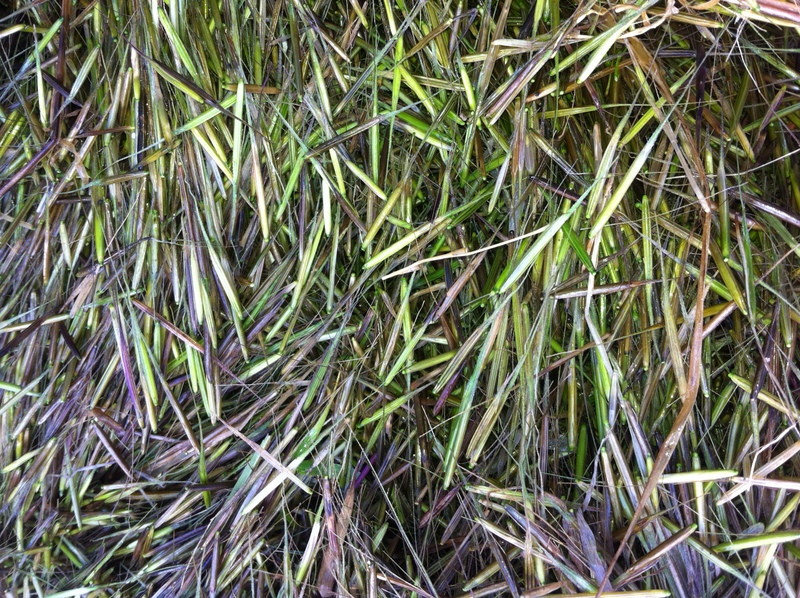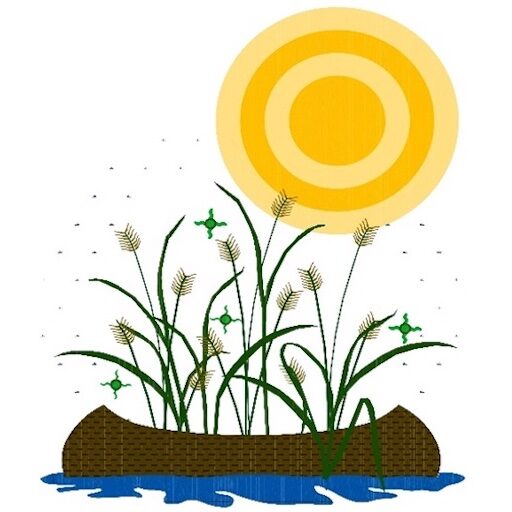The Ecology of Manoomin
Manoomin – The Good Seed
Manoomin is an annual aquatic plant that grows from seed each spring.
It is the only grain that is native to North America, with grain of sufficient size to be used as a staple food source by humans.
Extremely rich in carbohydrates, it converts easily to energy in the body; low in fat, it also contains protein essential to growth. Easily digested, it is rich in thiamin, riboflavin, and vitamin B. In the traditional Indian diet, wild rice was more nutritious on the whole than any other naturally available vegetable, grain, animal, or fruit source. Even the cultivated cereals introduced to North America (oats, barley, wheat, and rye) rank below wild rice in over-all nutritional value. — Vellum, 1988, p. 39; see also the USDA nutritional chart, p. 40
There are multiple varieties of manoomin, each adapted to their own regions’ climatic and geographic conditions.
Zizania aquatica aquatica or Southern Wild Rice – is present in Canada along the shores of the Great Lakes and along muddy shores of streams and ditches in Southern Ontario and Quebec. It occurs throughout Florida, Louisiana and the eastern seaboard states. It has limited distribution in Canada, and is only found in one location on the Trent-Severn Waterway (Beaver, 2020).
The main species of manoomin in the Kawartha Lakes Region is Zizania palustris or Northern Wild Rice, in some places there is further distinctions made between “lake rice” and “river rice” often based on the size of seed it produces. Northern Wild Rice grows extensively along many rivers or their lake-like expansions from the southern edge of the Precambrian Shield area in Alberta and Saskatchewan through Manitoba and Northwestern Ontario. It is also widespread in southern Ontario and is found within the water of the Trent-Severn Waterway and surrounding water systems as well as rivers flowing into the Ottawa River from the north and west. It occurs as far east as Nova Scotia and extends southward into the Northern United States (Beaver, 2010)
Manoomin Biology and Life Cycle
~ (Beaver, 2010; David, 2013; Dore 1971; Vennum 1998)…
- Manoomin starts to germinate in early to mid May with a primary root system, which is then further developed into a permanent root system that develops from each stem node. These lateral roots are what firmly anchors the plant so that it can manage the lifting forces of wave and water currents. It also can start to germinate under the late winter ice!
- Manoomin stems are also very interesting. The height of the manoomin stem is dependant on a whole host of environmental factors, such as depth of water, density of stand, where the plant is situated within the stand and nutrient status, etc. However, what they do have in common is internally the stems are hollow with air filled cavities that act as air locks that assist the plant with buoyancy. That is why when plants are uprooted (by wind and wave action, animals or human disturbance) they float and end up eventually at the shoreline because they can’t regain a foothold.
- After the first manoomin leaves emerge the plant develops thin, pale green ribbon like leaves that grow rapidly, because they don’t develop epicuticular wax (submerged stage). Each set of leaves it develops is larger as it reaches for the surface of the water, gradually sloughing off its preceding leaves. As the leaves reach the surface (floating leaf stage) they develop a waxy upper surface and plant tissue starts to differentiate which allows air to reach to all parts of the plant. These ribbon leaves persist until aerial shoots and leaves are well established (aerial stage). These emergent stems can reach from 2–8 ft above the water surface.
- Each manoomin plant develops both male and female flowers on each stalk usually in late July or early August depending on the area. White female flowers at the top of the stem with larger yellow male flowers below them.
- Wind pollinated and very dependant on weather conditions.
- Once pollinated, manoomin quickly begins to develop its grain, which continues for the next 4 -5 weeks. They start as light green with a milky interior and as they ripen the gain turns olive brown to dark brown/black.
- Manoomin starts to shed it ripe seeds (shattering) in late August through September, the seeds on any given plant do not ripen all at once.
- This feature is very important as it makes sure that the plant itself is able to reproduce itself. So that all the ripe seeds are not harvested all at one time by humans or any of the other beings who depend upon manoomin seeds for food.
Manoomin Habitat Requirements
Water depth is one of the main ecological requirements: thus making the way that the Trent-Severn Waterway functions a significant aspect of Manoomin’s ability to survive.
Manoomin Ecological Connections
Manoomin also provides food and habitat for a whole host of other living beings as well as ecosystem services that benefit us all.

Resources Used:
Beaver, J. (2010). Wild Rice Research and Restoration along the Trent -Severn Waterway 2010 Report. Parks Canada
David, P. (2013) Manoomin (Wild Rice) Seeding Guidelines. Great Lakes Indian Fish and Wildlife Commission.
Dore, W. (1971) Wild Rice, Canada Department of Agriculture, Ottawa, ON
Great Lakes Indian Fish and Wildlife Commission. (n.d) DRAFT Wisconsin State-Tribal Manoomin Management Plan.
Vennum, Thomas Jr. (2004 reprint of 1988) Wild Rice and the Ojibway People. St. Paul, Minnesota: Minnesota Historical Society Press. pp.358
